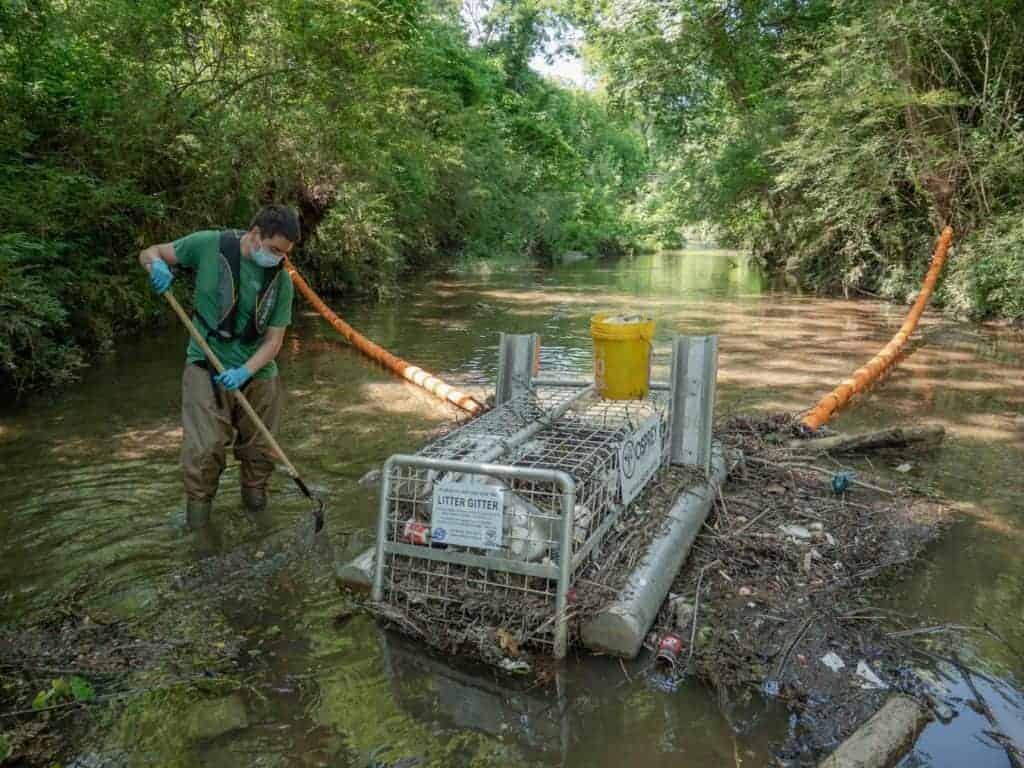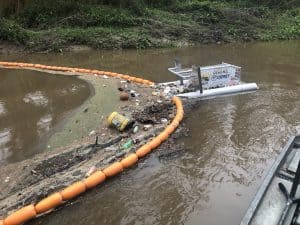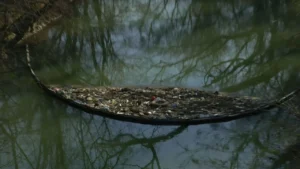Trash can be a galvanizing topic for most people, especially river and nature lovers. We are disgusted at the sight of the plastic bottles and bags, single-use products, Styrofoam, and balls of every sort that float in the water—moving from one riverbank to another on voyages downstream or sinking to the river bottom.
Most of the debris in the Chattahoochee River arrives via tributaries that serve as natural conduits from the storm drains that collect rainwater and trash from streets, parking lots, yards and commercial and industrial sites. Some trash is thrown directly into the river, usually off bridges: the out of sight, out of mind attitude that has historically been the way people have dealt with something they didn’t want—whether it be old furniture, appliances, tires (so many tires…), mattresses, toys, clothes, or even dead animals.
During Chattahoochee Riverkeeper’s (CRK) first twenty-five years, the organization removed at least two million pounds of trash and tires from the Chattahoochee, its tributaries and lakes with the help of thousands of volunteers—enough debris to fill twenty-five, eighteen-wheel tractor trailer trucks.
One of the strangest trash-related phone calls I ever received, when I was at CRK, came from an employee at a power plant on the Chattahoochee. She asked, matter-of-factly, if we would please remove a rotting goat from the river. It had apparently gotten “stuck” in an eddy in front of the plant’s water intake grate. Plant workers refused to make repairs to the intake until it, and the nauseating smell emanating from the carcass, were gone. I quickly declined, responding that our organization did not handle such waste and suggested that she speak with local animal control agencies.
In the years since I have retired, more goats—several hundred and all headless—have been found by CRK in the same general vicinity of the Chattahoochee: the apparent result of religious rituals that involve animal sacrifice. Remnants from these legal ceremonies have been found near the river, possibly sited for “convenient,” but illegal, animal disposal. On a recent trip in the CRK patrol boat, I saw one of the dead goats myself. Fortunately, most of the trash found in the river is not quite as disturbing, although it’s always infuriating that people view our rivers as places to dump what they do not want.
While groups like CRK continue to organize volunteer trash cleanups every year, there are other solutions to keep unwanted waste from polluting our waterways and littering roads, parks and neighborhoods.
For many years, Atlanta has considered—but never created—a stormwater utility, like those enacted by other cities in the region. A utility is a funding mechanism that provides the revenue a municipality needs to operate and maintain its drainage systems—in order to reduce flooding and keep pollutants, including trash, from flowing in rainwater to nearby streams. Each developed property is charged a cost-based, equitable fee that is fair, proportionate and based on impervious areas, such as roof tops, parking areas, and other hard surfaces. Programs implemented by a stormwater utility help stop and collect trash at its source—the places where it’s discarded—before it floats into the river that supplies our drinking water.
Innovative litter-collection devices offer a solution for trash removal in small streams—once the waste has been deposited there by storm runoff. The Litter Gitter is one small-stream device designed to catch floating trash using booms to guide the debris into a mesh container that can be mechanically-emptied after a rainstorm. To enhance durability in heavily-urbanized areas, fabricated aluminum tubing is used to build the trap and mesh basket; large fishing floats are used for the collection booms. Because it floats on the surface, the device allows heavy objects and wildlife to pass underneath.
Collaborating with Coca-Cola, Groundwork Atlanta/Georgia TRADE-UP, and Osprey Initiative, CRK created the Litter Gitter Pilot Program: a one-year effort to assess the efficacy of using these devices on a tributary to the Chattahoochee. Because Proctor Creek, which originates near downtown Atlanta, has a watershed with significant coverage of impervious surfaces, it was selected as the best stream in which to install the trash collectors—despite its flashiness, meaning that the creek rapidly collects flows from its developed watershed, producing turbulence and flood peaks.
During a massive storm earlier this year, Proctor Creek flooded in just a few hours, increasing in depth from an average 3.5 feet to 10.5 feet with a discharge (volumetric flow) rate of more than 2,000 cubic feet per second (cfs). For comparison, the discharge rate during dry weather is typically below 30 cfs. In such urban environments, the collection devices can be overwhelmed. Three traps were installed at sites in the creek that were selected for easy, safe access for trash removal; they were monitored and maintained for a year by the project team.
Using a method developed by the U.S. EPA to catalogue trash, the team learned, not surprisingly, that the five most frequently found items—in descending order—were: plastic beverage bottles, plastic water bottles, plastic bags, Styrofoam pieces, and Styrofoam cups. In fact, plastic made up eighty-two percent of the trash removed from the creek. The remaining categories reported by percentage in the project report are metal, paper, glass, and bulky items such as automotive parts, sports equipment, and tobacco products.
As sustainability advocate Annie Leonard says: “There is no such thing as ‘away.’ When we throw anything away, it must go somewhere.” If you can’t reuse or repurpose an item, that somewhere needs to be a recycling facility, composting center or municipal landfill—not a river.
For more about the Litter Gitter, visit chattahoochee.org/2020/10/11548/.
Sally Bethea is the retired executive director of Chattahoochee Riverkeeper and an environmental and sustainability advocate. Her award-winning Above the Waterline column appears monthly in INtown. This article originally appeared in INtown. View the original story here.




